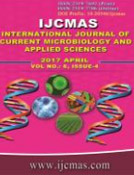


 National Academy of Agricultural Sciences (NAAS)
National Academy of Agricultural Sciences (NAAS)

|
PRINT ISSN : 2319-7692
Online ISSN : 2319-7706 Issues : 12 per year Publisher : Excellent Publishers Email : editorijcmas@gmail.com / submit@ijcmas.com Editor-in-chief: Dr.M.Prakash Index Copernicus ICV 2018: 95.39 NAAS RATING 2020: 5.38 |
Plants are exposed to a various biotic and abiotic stresses that can affect either directly or indirectly the photosynthetic performance of leaves. Several imaging techniques have been used to detect the early signs of stress by monitoring changes in water status, photosynthetic performance or structural modifications. Commonly, a more promising alternative technique is the use of chlorophyll fluorescence (ChF) which has a better agreement with photosynthesis and it has been used for the early detection of stress such as nutrient stress, heat stress, water stress, pathogen attack or herbicide toxicity. In plants, absorbed light can undergo three fates viz., photosynthetic quantum conversion, chlorophyll fluorescence (ChF) and heat dissipation. Under stress condition absorbed light cannot completely used for carbon fixation and this excess energy is re-emitted back at longer wavelength, known as chlorophyll fluorescence. The fluorescence images and the corresponding fluorescence ratio blue: red and blue: far-red are particularly sensitive to environmental changes and stress. Different fluorescence parameters like maximum quantum efficiency of PSII (FV/ Fm), photochemical quenching (qP) and quantum efficiency of PSII (ɸPSII) are used for stress monitoring. This technique is limited up to the single leaves or seedling stage of crop and sometimes, this technique does not appear suitable for the early detection of water stress.
Chlorophyll fluorescence, Biotic stress, Abiotic stress, FV/ Fm.
Int.J.Curr.Microbiol.App.Sci. 6(4): 568-575. doi: https://doi.org/10.20546/ijcmas.2017.604.068 |
 |
 |
 |
 |